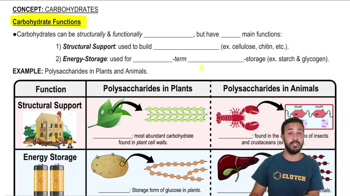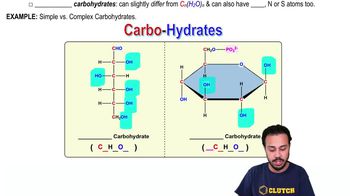Table of contents
- 1. Introduction to Biology2h 42m
- 2. Chemistry3h 40m
- 3. Water1h 26m
- 4. Biomolecules2h 23m
- 5. Cell Components2h 26m
- 6. The Membrane2h 31m
- 7. Energy and Metabolism2h 0m
- 8. Respiration2h 40m
- 9. Photosynthesis2h 49m
- 10. Cell Signaling59m
- 11. Cell Division2h 47m
- 12. Meiosis2h 0m
- 13. Mendelian Genetics4h 44m
- Introduction to Mendel's Experiments7m
- Genotype vs. Phenotype17m
- Punnett Squares13m
- Mendel's Experiments26m
- Mendel's Laws18m
- Monohybrid Crosses19m
- Test Crosses14m
- Dihybrid Crosses20m
- Punnett Square Probability26m
- Incomplete Dominance vs. Codominance20m
- Epistasis7m
- Non-Mendelian Genetics12m
- Pedigrees6m
- Autosomal Inheritance21m
- Sex-Linked Inheritance43m
- X-Inactivation9m
- 14. DNA Synthesis2h 27m
- 15. Gene Expression3h 20m
- 16. Regulation of Expression3h 31m
- Introduction to Regulation of Gene Expression13m
- Prokaryotic Gene Regulation via Operons27m
- The Lac Operon21m
- Glucose's Impact on Lac Operon25m
- The Trp Operon20m
- Review of the Lac Operon & Trp Operon11m
- Introduction to Eukaryotic Gene Regulation9m
- Eukaryotic Chromatin Modifications16m
- Eukaryotic Transcriptional Control22m
- Eukaryotic Post-Transcriptional Regulation28m
- Eukaryotic Post-Translational Regulation13m
- 17. Viruses37m
- 18. Biotechnology2h 58m
- 19. Genomics17m
- 20. Development1h 5m
- 21. Evolution3h 1m
- 22. Evolution of Populations3h 52m
- 23. Speciation1h 37m
- 24. History of Life on Earth2h 6m
- 25. Phylogeny2h 31m
- 26. Prokaryotes4h 59m
- 27. Protists1h 12m
- 28. Plants1h 22m
- 29. Fungi36m
- 30. Overview of Animals34m
- 31. Invertebrates1h 2m
- 32. Vertebrates50m
- 33. Plant Anatomy1h 3m
- 34. Vascular Plant Transport1h 2m
- 35. Soil37m
- 36. Plant Reproduction47m
- 37. Plant Sensation and Response1h 9m
- 38. Animal Form and Function1h 19m
- 39. Digestive System1h 10m
- 40. Circulatory System1h 57m
- 41. Immune System1h 12m
- 42. Osmoregulation and Excretion50m
- 43. Endocrine System1h 4m
- 44. Animal Reproduction1h 2m
- 45. Nervous System1h 55m
- 46. Sensory Systems46m
- 47. Muscle Systems23m
- 48. Ecology3h 11m
- Introduction to Ecology20m
- Biogeography14m
- Earth's Climate Patterns50m
- Introduction to Terrestrial Biomes10m
- Terrestrial Biomes: Near Equator13m
- Terrestrial Biomes: Temperate Regions10m
- Terrestrial Biomes: Northern Regions15m
- Introduction to Aquatic Biomes27m
- Freshwater Aquatic Biomes14m
- Marine Aquatic Biomes13m
- 49. Animal Behavior28m
- 50. Population Ecology3h 41m
- Introduction to Population Ecology28m
- Population Sampling Methods23m
- Life History12m
- Population Demography17m
- Factors Limiting Population Growth14m
- Introduction to Population Growth Models22m
- Linear Population Growth6m
- Exponential Population Growth29m
- Logistic Population Growth32m
- r/K Selection10m
- The Human Population22m
- 51. Community Ecology2h 46m
- Introduction to Community Ecology2m
- Introduction to Community Interactions9m
- Community Interactions: Competition (-/-)38m
- Community Interactions: Exploitation (+/-)23m
- Community Interactions: Mutualism (+/+) & Commensalism (+/0)9m
- Community Structure35m
- Community Dynamics26m
- Geographic Impact on Communities21m
- 52. Ecosystems2h 36m
- 53. Conservation Biology24m
4. Biomolecules
Carbohydrates
Problem 2`
Textbook Question
The enzyme amylase can break glycosidic linkages between glucose monomers only if the monomers are in the α form. Which of the following could amylase break down?
a. glycogen, starch, and amylopectin
b. glycogen and cellulose
c. cellulose and chitin
d. starch, chitin, and cellulose
 Verified step by step guidance
Verified step by step guidance1
Understand the structure of glucose monomers: Glucose can exist in two forms, α (alpha) and β (beta). The α form has the hydroxyl group on the first carbon below the plane of the ring, while the β form has it above.
Identify the types of glycosidic linkages: Glycosidic linkages can be α or β, depending on the orientation of the glucose monomers. Amylase specifically breaks α-glycosidic linkages.
Examine the composition of each polysaccharide: Glycogen, starch, and amylopectin are composed of glucose monomers linked by α-glycosidic bonds, whereas cellulose and chitin are composed of β-glycosidic bonds.
Determine which polysaccharides amylase can break down: Since amylase can only break α-glycosidic linkages, it can break down glycogen, starch, and amylopectin.
Conclude which option is correct: Based on the ability of amylase to break α-glycosidic linkages, the correct answer is option a: glycogen, starch, and amylopectin.
 Verified video answer for a similar problem:
Verified video answer for a similar problem:This video solution was recommended by our tutors as helpful for the problem above
Video duration:
2mPlay a video:
Was this helpful?
Key Concepts
Here are the essential concepts you must grasp in order to answer the question correctly.
Glycosidic Linkages
Glycosidic linkages are covalent bonds that connect carbohydrate (sugar) molecules to one another. These linkages can vary in structure, such as α (alpha) or β (beta) forms, which affect the properties and digestibility of the polysaccharides. Enzymes like amylase are specific to the type of glycosidic linkage they can cleave, with amylase specifically targeting α linkages.
Recommended video:
Guided course

Formation & Breakdown of Polysaccharides
Alpha and Beta Glucose
Glucose can exist in two different structural forms: alpha (α) and beta (β). The difference lies in the orientation of the hydroxyl group on the first carbon atom. In α-glucose, the hydroxyl group is below the plane of the ring, while in β-glucose, it is above. This distinction is crucial because it determines the type of glycosidic bonds formed and the enzyme specificity for breaking these bonds.
Recommended video:
Guided course

Glucose's Impact on Lac Operon Example 1
Polysaccharides: Glycogen, Starch, Cellulose, and Chitin
Polysaccharides are long chains of monosaccharides linked by glycosidic bonds. Glycogen and starch are composed of α-glucose units, making them substrates for amylase. In contrast, cellulose and chitin consist of β-glucose units, which amylase cannot break down. Understanding the composition of these polysaccharides is essential to determine which can be digested by specific enzymes.
Recommended video:
Guided course

Carbohydrate Functions
Related Videos
Related Practice














